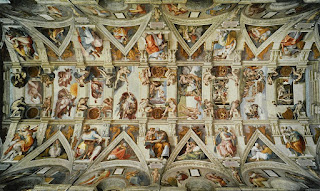What's Up? Comparing ceiling paintings in Rome

Jimmy Guardiola In the month we spent in Rome, we saw countless amazing pieces of art. The oldest and most spectacular sculptures, the most intricate sarcophagi, the most colorful paintings, and the most breathtaking architectural achievements. All in all, however, the greatest things I saw consistently were the ceiling paintings. Whether fresco or canvas, it seemed that everyone one we saw was better than the last. It is impossible to register and memorize all the art contained in one single church. Most churches of ceiling works in the main naive, in each chapel, the cupola, the transepts, and the apse. Though I can spend hours talking about each, for this, I will focus on the ones located in the main naive. The very first thing you seem with great detail as you look up when entering a church. I'm going to be comparing my two favorite pieces. one actually is from a church, however, the second in located in a famous palazzo. The first is "The Triumph of the Name of Jesus...


